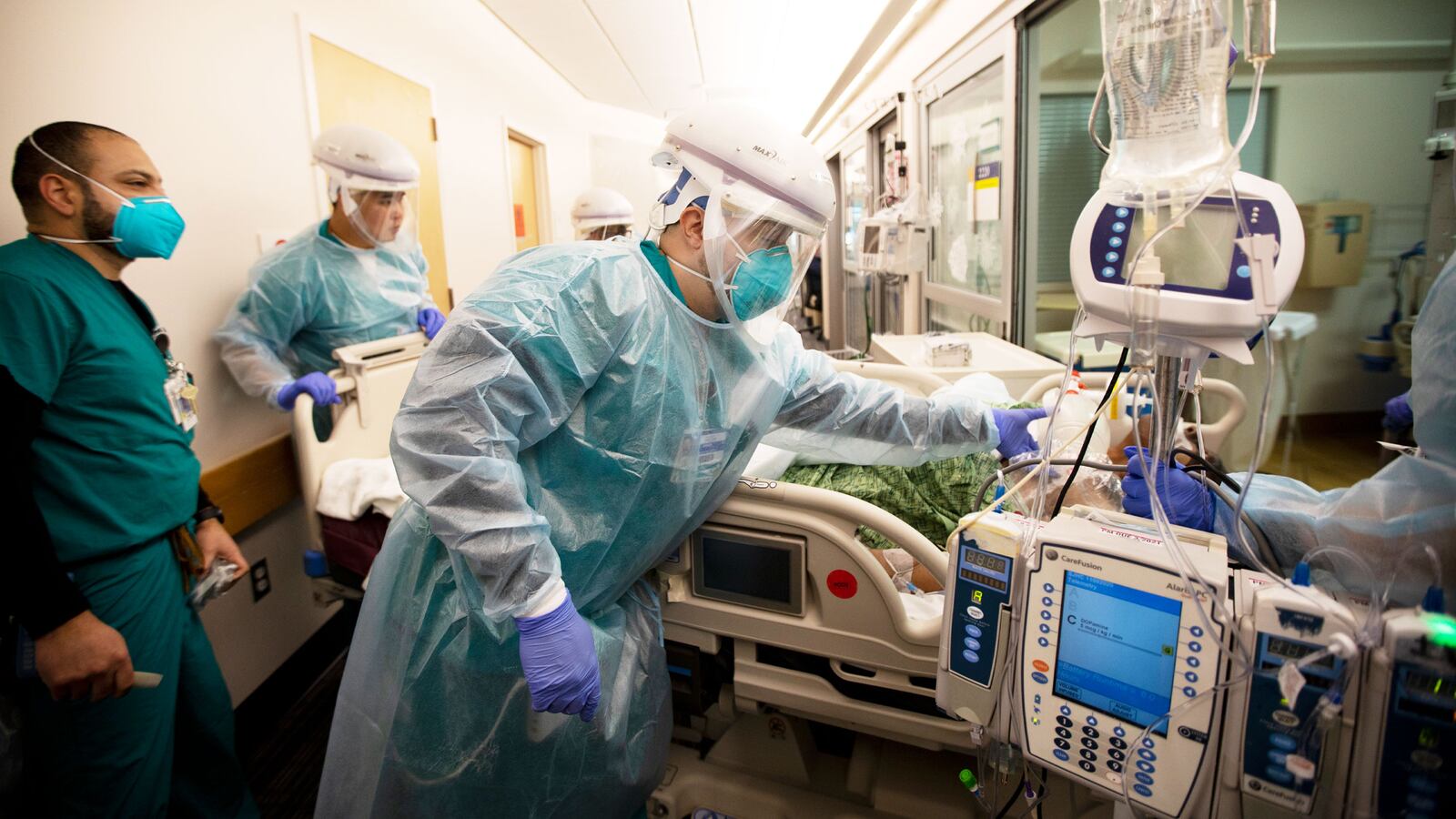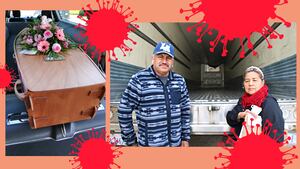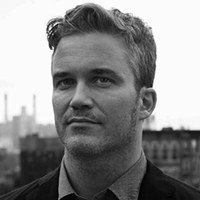LOS ANGELES—On Monday, a visibly exhausted ambulance driver began to unload a COVID-19 patient in critical condition outside the emergency room at Adventist Health White Memorial, just east of downtown.
Then he sat down to wait for the hospital to find an open bed.
The driver, who asked to remain anonymous because the private company for which he works did not authorize him to speak publicly, opened a bag of potato chips for his dinner. An hour passed, and a computer in the front seat lit up like a Christmas tree with new emergency calls.
The experience was no outlier.
“We call it holding a wall, because we stand in the hallways, and stand there next to the patient while they’re on a gurney,” L.A. City Firefighter Paramedic Tanya Crabbe told The Daily Beast. “We don’t know how long wait times will be at the hospital. All that unknown—it puts that one extra layer on.
“How much more before we burst at the seams?”
COVID-19 is so badly overwhelming hospitals in Southern California that ICU departments have been hovering at zero capacity for weeks, oxygen is in short supply, and emergency rooms have had to expand into hallways, lobbies, and gift shops. County ambulance crews were told Monday to cut back on their use of oxygen so it can be reserved for the patients who need it most. Only patients with oxygen saturation rates below 90 percent will get it, even though a reading below 95 percent is abnormal for most people.
The oxygen directive came days after the L.A. County Emergency Medical Services Agency told paramedics they should not take patients who cannot be resuscitated in the field to the hospital for further life-saving efforts and should instead declare them dead.
L.A. has seen a cumulative total of more than 800,000 coronavirus infections since the start of the outbreak in March—with more than half of them reported since Dec. 1. But perhaps the most tell-tale sign of the county’s latest COVID-19 crisis is the sight of ambulances holding the wall, as EMTs and paramedics call waiting with a patient for a bed to open up. Sometimes they keep the patients inside the ambulance. Other times it’s in the hallways of the ER or in the ambulance bay or in and around disaster tents.
Last week, the driver outside Adventist told The Daily Beast, holding a potato chip, that he and his partner waited three hours to drop off a patient with fever and shortness of breath at Kaiser Permanente Baldwin Park Medical Center. Dr. Gregory Kelman, the regional medical director of operations at Kaiser Permanente Southern California, said in a statement that hospitals in the managed care consortium have “triage processes and procedures in place at all times for ensuring that the least stable patients are unloaded from emergency medical service vehicles quickly.”
But drivers said the idea that drivers or facilities were keeping up was laughable.
“As soon as we leave the hospital, we’ll get another call,” the driver said. “Every time you think the number of calls is peaking, it just seems to get worse.”
It’s a systemic problem—and there’s little hope in sight.
“We’re doing all we can to mitigate adverse impacts of the crisis, but this is really uncharted territory right now,” said Dr. Marc Eckstein, commander of L.A.’s emergency medical services bureau and medical director of the L.A. Fire Department. “There’s no beds, there’s no beds. No matter who you are, no matter who you know, no matter how good of health insurance you have, there’s no beds for you right now.”
At any one time in recent days, up to 90 percent of the emergency departments in L.A. have been temporarily unable to accept new patients via ambulance transport, according to the county health department. Ambulances have had to wait up to nine hours to transfer care—with up to 19 ambulances waiting to unload patients—according to Eckstein, stretching the 911 emergency response system to the breaking point.
“We have patients we respond to who are dying of hypoxia from COVID pneumonia and they’re alone in the emergency department in the hospital and the best we can do is arrange a Facetime so they can see their family members virtually,” Eckstein said.
“People who take themselves to the emergency department at a lot of these hospitals are waiting 12-18 hours to get seen,” he added.
And county health officials predict the worst is yet to come, as more and more people infected in gatherings during the Christmas and New Year holidays begin to worsen and require hospitalization. Already, the unparalleled surge in new COVID cases pushed several hospitals to declare "internal disasters" over the weekend—one step away from having to ration care and close their doors to ambulances entirely.
On Tuesday, L.A. County surpassed 11,000 deaths from COVID-19. Director of Public Health Barbara Ferrer in a statement called the cumulative total a "terrible milestone." On average, a new person in L.A. was succumbing to the deadly respiratory illness every 8 minutes over the past week.
The longer wait times can be especially pronounced at smaller community hospitals, which are unaccustomed to treating the scale or severity of the illness now spreading like wildfire in L.A. Tales of hospital employees taking on entirely new jobs to stem the tide were common as the medical infrastructure of an entire region came close to buckling.
Nerissa Black, a nurse at Henry Mayo Newhall Hospital in Valencia, told The Daily Beast that someone from the financial department was working as a ward clerk answering telephones in one unit because the hospital is so short-staffed. “Last week, I admitted a patient for a heart attack who said he had been waiting overnight in a tent outside the ER, and it was very cold,” Black said.
“The system has never been taxed like this before—especially with a sustained problem like this that’s widespread,” said Eckstein of the L.A. Fire Department. “We’re seeing patients in their thirties and forties and people with no known risk factors dying of COVID.”
L.A. Mayor Eric Garcetti said Sunday that the proportion of people who had died from COVID-19 with underlying medical conditions dropped to 86 percent from 92 percent earlier in the pandemic. In other words, the area is seeing younger patients with fewer or no risk factors succumb to the virus.
Since December, the fire departments of L.A. City and County have also seen a big spike in COVID infections among paramedics and EMTs. Some 191 Los Angeles city firefighters, paramedics, and support staff were out sick with COVID and isolating or recovering at home, a department spokesman told The Daily Beast on Tuesday. A handful of fire stations have had to be temporarily shut for decontamination after a spike in cases occurred among firefighters living in close quarters in the station houses. In total, 779 of the 3,345 firefighters and paramedics and related staff in the L.A. city fire department had tested positive for COVID-19 since the pandemic began, according to data provided by the department on Wednesday.
On New Year’s Day, L.A. City Fire Captain George Roque died of COVID, aged 57. It hit hard among workers struggling to keep pace.
“With a wildfire, we’re gone for 7-14 days and then we come home, take a shower, go to bed,” Crabbe said. “This has been going on for so long and just when you thought it was getting better, the surge is just crazy.”
After an hour of waiting at Adventist Health this week, the driver and his partner expected to soon be back in the field. But in the meantime, they listened to the two-way radio squawk out radio calls that their service was too busy to answer.
“We hear them, but we don’t have any ambulances available to take the call,” he said.









